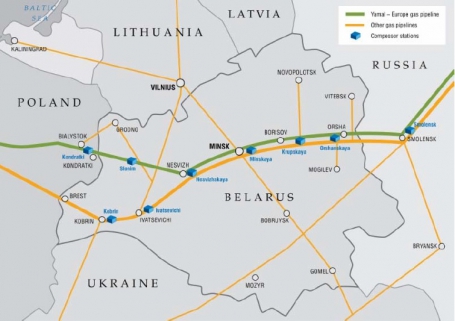Russia to Upgrade Belarus GTS
Russia will invest $3.5bn in the Gazprom-owned gas transport system of Belarus, Russia's president Vladimir Putin told a meeting of the union state supreme state council, the Kremlin reported June 19. Of that total, $2.5bn will go on renovating the Belarusian section of the Yamal-Europe gas pipeline and the rest on additional underground gas storage facilities (UGS). The aim is to modernise the system by the end of the decade, the statement said.
"Given the technical condition of other routes for the export of Russian hydrocarbons, in particular gas, to Europe, they are, frankly speaking, unsatisfactory. So the Belarusian route becomes more important," Putin added, no doubt referring to Ukraine. The US has informed western European companies of the risks they face if they finance NS2, although much of the money due from the the five has already been sent to Switzerland, home of NS2 AG. Poland is also seeking to block NS2, on grounds that it is in breach of competition law.
Gazprom exported about 194.4bn Russian m3 gas to EU in 2017, of which more than a fifth went through Belarus. Gazprom owns three UGSs in Belarus, totalling about 1.1bn m3.

Source: Gazprom
Russia is also developing Nord Stream 2 (NS2) with 55bn m3/yr capacity, running directly from the St Petersburg region to northeast Germany under the Baltic Sea, bypassing traditional routes Belarus and Ukraine.
NS2 AG plans to begin building the offshore section of the gas pipeline in the summer of 2018, CFO Paul Corcoran told the Russian oil and gas congress, local media reported June 18.
Corcoran said that more than half of the capital investments, which are €8bn ($9.25bn) have already been invested and the construction of the gas pipeline will begin immediately on receipt of the final permits from Denmark and Russia. At present 96% of the linepipe has been supplied for the project, he added.
“The purchase of Russian gas through NS2 in 2020 will allow the European Union (EU) to save from €7.9bn to €24.4bn compared with the purchase of LNG,” Corcoran said. The range depends on high or low case scenarios for LNG demand and was calculated by the institute of energy economics, EWI, at Cologne University in a study that Gazprom commissioned to establish the commercial case for NS2.
Gazprom also has made the argument that as its production base goes further north into the giant fields of the Yamal Peninsula, so it needs a more northerly and hence shorter and cheaper transport system than Ukraine, which was built decades ago to deliver gas from fields that are now depleting.
So far, Germany, Finland and Sweden have granted all the necessary permits for construction and operation of the pipeline. Russia gave first approval for the construction in the Russian section of the pipeline June 7. The second permit to construct an underwater pipeline in the territorial sea of the Russian Federation will be obtained in the very near future, Gazprom said. The national permitting procedure in Denmark is also ongoing, although it cannot block the pipeline outright, only force it to take a costly detour.



